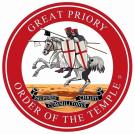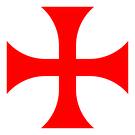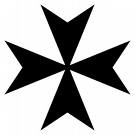|
|
 The Orders can claim to have inherited little more than the names of the two Knightly fraternities which were formed in the Holy Land at the time of the First Crusade. That of “Knights Templar” was derived from the fact that, in 1118, King Baldwin II granted the members of the original Order quarters on the reputed site of King Solomon’s Temple – more probably it was the site of the King’s Palace stables. Before this, in 1113, Pope Paschal II had given a Charter to the guardians of the Hospital of St. John of Jerusalem, the “Knights Hospitaller”, who when driven from the Holy Land were eventually granted the island of Malta and became known as “The Knights of Malta”. The latter ceased to exist as a military force in 1798. The Orders can claim to have inherited little more than the names of the two Knightly fraternities which were formed in the Holy Land at the time of the First Crusade. That of “Knights Templar” was derived from the fact that, in 1118, King Baldwin II granted the members of the original Order quarters on the reputed site of King Solomon’s Temple – more probably it was the site of the King’s Palace stables. Before this, in 1113, Pope Paschal II had given a Charter to the guardians of the Hospital of St. John of Jerusalem, the “Knights Hospitaller”, who when driven from the Holy Land were eventually granted the island of Malta and became known as “The Knights of Malta”. The latter ceased to exist as a military force in 1798.
Today the Masonic Orders comprise the following degrees:
 Knights TemplarThe candidate is admitted in the character and attire of a pilgrim and is first required symbolically to undertake a period of pilgrimage. After taking an Obligation in the name of The Holy, Blessed and Glorious Trinity, he assumes the dress of a Soldier of the Cross and symbolically proceeds on a period of warfare. He is instructed how penance and meditation play a vital part in the preparation for Knighthood. After this he is received, armed and proclaimed a Knight of the Temple. Knights TemplarThe candidate is admitted in the character and attire of a pilgrim and is first required symbolically to undertake a period of pilgrimage. After taking an Obligation in the name of The Holy, Blessed and Glorious Trinity, he assumes the dress of a Soldier of the Cross and symbolically proceeds on a period of warfare. He is instructed how penance and meditation play a vital part in the preparation for Knighthood. After this he is received, armed and proclaimed a Knight of the Temple.
Knight of St. Paul
This is a short passing degree conferred in a room adjoining a Priory of Malta in the course of which the Mediterranean password is communicated. The degree is based on Scriptural readings telling of St. Paul’s travels and how he arrived on the island of Malta.
Knight of St. John of Jerusalem, Palestine, Rhodes and Malta
 The subsequent history of the Knights Hospitaller and their arrival in the island of Malta, is recounted The subsequent history of the Knights Hospitaller and their arrival in the island of Malta, is recounted
in this further degree of the Christian Masonic Knighthood. The ritual is designed to emphasise the various elements basic to the Christian Faith.
In the 1740’s specifically Christian Masonic Rites began to appear in France and possibly in England also. For the most part these Rites were “chivalric” and by the 1770’s vestiges of the Templar-Malta ceremonies had reached England.
These were originally worked as a single Degree, possibly in association with others with which we are familiar today and the ceremonies took place in “Encampments” derived from the Royal Arch Chapters under the Grand Lodge of the “Ancients”.
The earliest reference to Knights Templar (K.T.) activity in England can be found in the minutes of the Chapter of Friendship (Royal Arch) in Portsmouth dated 1778 where it was worked as an Appendant Degree. In 1791 a Grand Conclave was formed comprising of seven “Encampments” with Thomas Dunckerley as Grand Master.
After the Union in 1813, the Duke of Sussex became Grand Master, but it was only after his death in 1843 that the Orders flourished with renewed vigour. Although “Encampments” later became known as “Preceptories” and the “Grand Conclave” changed it’s name to “Great Priory”, the latter is the longest established English Masonic authority, after the Grand Lodge of the Craft itself.
Great Priory presides over more than 600 Preceptories at home and abroad each of which works the “Official” ritual – the exceptions being the “Baldwyn Rite” at Bristol and “Antiquity” at Bath; they are grouped into 39 Provincial Priories. Great Priory meets each year on the third Wednesday in May and the third Tuesday in November, with all members of the Orders eligible to attend.
The Orders give considerable support to the St. John of Jerusalem Eye Hospital, a charitable foundation of the non-Masonic, Venerable Order of St. John. For more information on this please go to the Charity page of our website.
The Templar Hymn
“For All the Saints Who from Their Labours Rest”
(William W. How, 1823-1897)
For all the Saints, who from their labours rest,
Who Thee by faith before the world confessed,
Thy Name, O Jesu, be forever blessed,
Alleluia, Alleluia!
O may Thy soldiers, faithful, true and bold,
Fight as the Saints who nobly fought of old,
And win, with them, the victor’s crown of gold,
Alleluia, Alleluia!
From earth’s wide bounds, from ocean’s farthest coast,
Through gates of pearl streams in the countless host,
Singing to Father, Son and Holy Ghost,
Alleluia, Alleluia!
|
 The Orders can claim to have inherited little more than the names of the two Knightly fraternities which were formed in the Holy Land at the time of the First Crusade. That of “Knights Templar” was derived from the fact that, in 1118, King Baldwin II granted the members of the original Order quarters on the reputed site of King Solomon’s Temple – more probably it was the site of the King’s Palace stables. Before this, in 1113, Pope Paschal II had given a Charter to the guardians of the Hospital of St. John of Jerusalem, the “Knights Hospitaller”, who when driven from the Holy Land were eventually granted the island of Malta and became known as “The Knights of Malta”. The latter ceased to exist as a military force in 1798.
The Orders can claim to have inherited little more than the names of the two Knightly fraternities which were formed in the Holy Land at the time of the First Crusade. That of “Knights Templar” was derived from the fact that, in 1118, King Baldwin II granted the members of the original Order quarters on the reputed site of King Solomon’s Temple – more probably it was the site of the King’s Palace stables. Before this, in 1113, Pope Paschal II had given a Charter to the guardians of the Hospital of St. John of Jerusalem, the “Knights Hospitaller”, who when driven from the Holy Land were eventually granted the island of Malta and became known as “The Knights of Malta”. The latter ceased to exist as a military force in 1798. Knights TemplarThe candidate is admitted in the character and attire of a pilgrim and is first required symbolically to undertake a period of pilgrimage. After taking an Obligation in the name of The Holy, Blessed and Glorious Trinity, he assumes the dress of a Soldier of the Cross and symbolically proceeds on a period of warfare. He is instructed how penance and meditation play a vital part in the preparation for Knighthood. After this he is received, armed and proclaimed a Knight of the Temple.
Knights TemplarThe candidate is admitted in the character and attire of a pilgrim and is first required symbolically to undertake a period of pilgrimage. After taking an Obligation in the name of The Holy, Blessed and Glorious Trinity, he assumes the dress of a Soldier of the Cross and symbolically proceeds on a period of warfare. He is instructed how penance and meditation play a vital part in the preparation for Knighthood. After this he is received, armed and proclaimed a Knight of the Temple.

 The subsequent history of the Knights Hospitaller and their arrival in the island of Malta, is recounted
The subsequent history of the Knights Hospitaller and their arrival in the island of Malta, is recounted